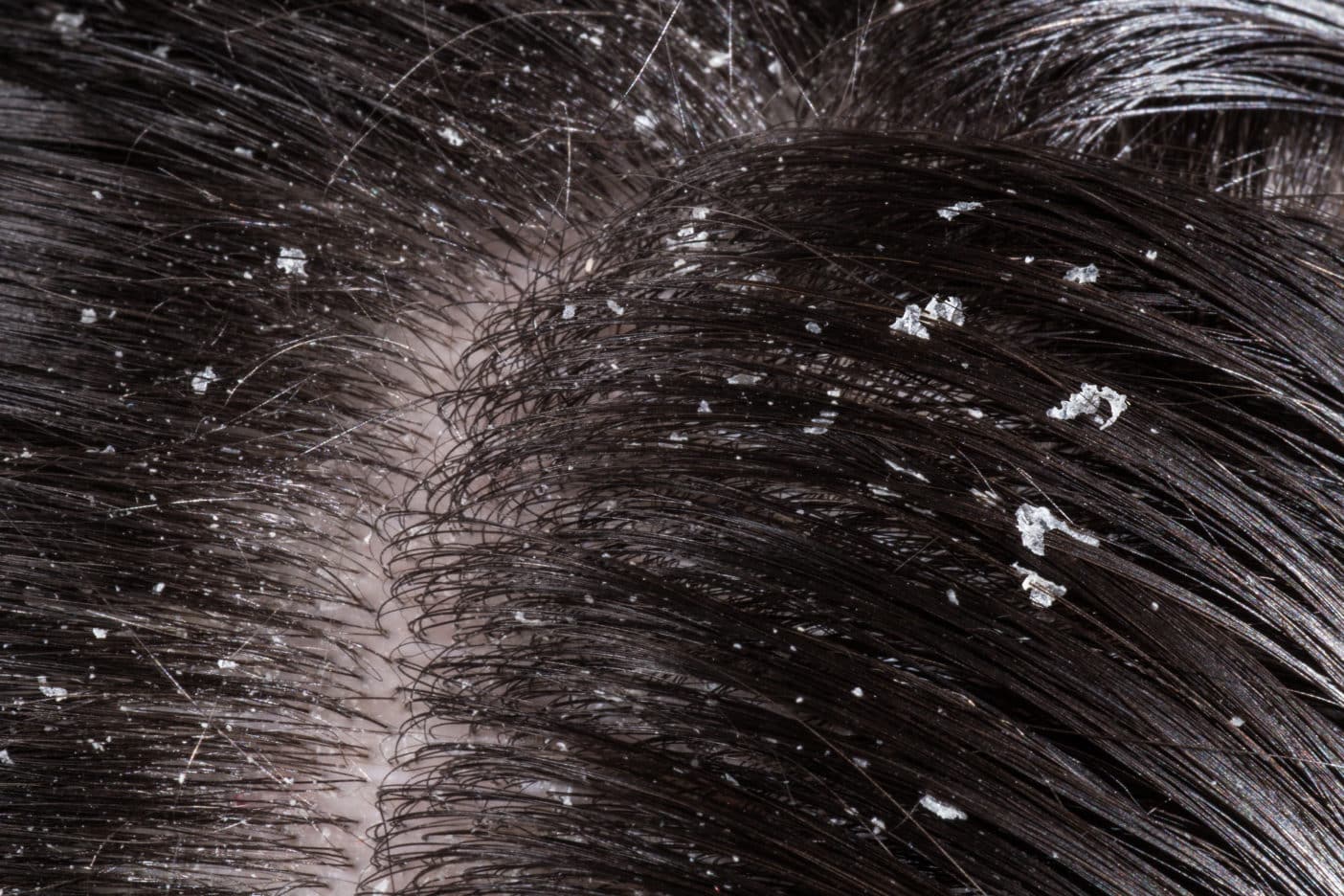Dandruff

They are unpleasant and really embarrassing: dandruff. If the scales trickle down from the head onto the shoulders, they are usually immediately noticeable on clothing. But dandruff is by no means rare, quite the opposite. More than a third of all Europeans are plagued by this mostly cosmetic problem at least once in their lives. However, anti-dandruff products can help against scurf.
How dandruff develops
Basically, everyone sheds scales in the course of a day. This is completely normal, as our skin renews itself approximately every four weeks. Dead skin cells are shed as part of this process. However, these flakes are so tiny that they are barely visible to the eye and are not noticeable. Only when the old cells of the scalp are shed too quickly and in large quantities, and then also clump together, do they become noticeable as the typical dandruff. To the human eye, clumps of around 500 cells or more are visible.
Why is there dry and greasy dandruff?
Medically, dandruff is divided into two categories. On the one hand, there is dry dandruff. It is typically almost snow-white in colour and usually forms when the scalp is also rather dry and low in oil. Hair care products that are too aggressive and degreasing, dry heating air in winter, air conditioning, hot blow-drying and living in hot and dry areas all promote the formation of this dandruff. However, sometimes the cause is also due to illness: dry dandruff is a typical side effect of psoriasis (psoriasis vulgaris), for example. Contact allergies, atopic and seborrhoeic eczema can also cause dry dandruff. Many women going through the menopause are also affected.
Oily dandruff looks yellowish and feels oily. It is almost always larger than dry dandruff. Due to their sticky and greasy nature, the flakes are less likely to trickle onto the shoulders and instead remain in the hair. This is triggered by increased sebum production, which can have various causes. For example, it is not uncommon for the lipophilic yeast Malassezia furfur, which is actually part of our normal skin flora, to proliferate. Why the yeast fungus suddenly multiplies so excessively in some people has not yet been sufficiently clarified.
A predisposition is suspected in those affected, and pre-existing conditions such as diabetes or a weakened immune system are also associated with the strong growth of Malassezia furfur. Hormone fluctuations during puberty are also among the causes of yellowish oily dandruff.
Incidentally, oily scurf is more common in men than in women. As their glands naturally secrete more sebum, they also tend to have a greasier scalp.
In most cases, dandruff is purely a cosmetic problem. However, a visit to the dermatologist is recommended if there is itching and/or inflammation on the scalp. If the itchy areas of skin around the scurf are scratched, bacteria can easily settle here.
These products and active ingredients are available to combat dandruff
Anti-dandruff shampoo is one of the best-known and most effective products. However, it is only suitable to a limited extent for people with dry scalps, as it dries out and irritates the scalp even further. It should therefore always contain active ingredients that provide the scalp with additional moisture. Alternatively, lotions are also suitable for very dry scalps, while a tonic should be the first choice for oily scalps. If the yeast fungus Malassezia furfur is the cause, a shampoo with the fungicidal and antibacterial active ingredient piroctone olamine is usually recommended. The active ingredient climbazole, on the other hand, has fallen into disrepute, because although the chemical compound is considered to be extremely antifungal and fungistatic, it is also said to be allergenic and even carcinogenic. As early as 2007, the Federal Ministry of Consumer Protection set a maximum value of 0.5 per cent climbazole for cosmetic and hair care products. However, critics emphasise that this maximum limit is not sufficient as a protective measure. Climbazole also has a massive impact on the environment. In contrast, anti-dandruff shampoos with salicylic acid have not yet been criticised. The active ingredient gently and reliably removes dandruff and makes the underlying skin more receptive to moisturising substances. In accordance with Regulation (EC) No. 1223/2009 on cosmetic products, salicylic acid is authorised as an anti-dandruff agent in hair care products in a concentration of up to 3 percent.
Then there is ursolic acid, which belongs to the triterpenoid group of substances. It is anti-inflammatory and inhibits the formation of certain hormones and enzymes that are significantly involved in the development of pain and inflammatory processes. Ursolic acid occurs naturally in herbs such as rosemary, thyme, basil and savory.
Profile of piroctone olamine
INCI: Piroctone Olamine
Description: yellow solid
CAS number: 68890-66-4
Effect: fungicidal and antibacterial
Profile Climbazole
INCI: Climbazole
Description: white crystalline powder
CAS number: 38083-17-9
EINECS/ELINCS-Nummer: 253-775-4
Effect: antifungal
Note: is suspected of being carcinogenic
Salicylic acid profile
INCI: Salicylic Acid
Description: colourless and odourless crystals
CAS number: 69-72-7
Effect: antimicrobial, anti-inflammatory, analgesic
Note: authorised for natural cosmetics
Ursolic acid profile
INCI: Sodium ursolate, sodium oleanolate
CAS number: 77-52-1
Description: colourless crystal needles
Effect: anti-inflammatory, antimicrobial, stabilises liposomal membranes
Natural complexes against dandruff
Copaiba balsam has long played a major role in Brazilian herbal medicine. The active ingredient is extracted from the resin of the copaiba tree and has proven anti-inflammatory and antiseptic properties. The Copaifera Officinalis (Balsam Copaiba) Resin (and) Bertholletia Excelsa Seed Oil complex is of particular interest in the treatment of dandruff. Bertholletia Excelsa Seed Oil is oil that is extracted from edible Brazil nuts. It consists of around 43 per cent linoleic acid, around 30 per cent oleic acid, 14 per cent palmitic acid and around 12 per cent stearic acid.
The complex has an antiseborrhoeic and anti-inflammatory effect and can be used in products for dry or oily hair with a tendency to dandruff. Possible applications include shampoos, conditioners, hair lotions, gels and tonics.
Another synergistic and botanical complex can be used to combat itching, purify the scalp and stimulate localised blood circulation. The complex developed under the INCI name Aqua (and) Propylene Glycol (and) Thymus Serpyllum Extract (and) Adiantum Capillus-Veneris Leaf Extract has an antiseptic and soothing effect and reduces the formation of dandruff. Ingredients include the extract of the common maidenhair fern Adiantum Capillus-Veneris and thyme extract (Thymus Serpyllum Extract).
Tea tree oil is also a gentle but effective active ingredient against dandruff, as it has antibacterial, antifungal and strong antimicrobial properties. It soothes the structure of the scalp and can counteract inflammation and irritation.
Willow has been one of the most important medicinal plants for centuries. The valuable willow bark extract contains polyphenols and salicin, among other things, and has a skin-soothing and antimicrobial effect. It is therefore also suitable for natural products against dandruff.
Profile of Copaiba Balsam
INCI: Copaifera Officinalis (Copaiba) Oil
CAS number: 8001-61-4
EINECS number: 232-288-0
Plant of origin: Copaifera officinalis
Description: light, viscous, clear liquid
Odour: spicy
Main constituent: Copaivic acid (Acidum copaivicum)
Effect: anti-inflammatory and antiseptic
Profile Anti-Dandruff Complex
INCI: Aqua (and) Propylene Glycol (and) Thymus Serpyllum Extract (and) Adiantum Capillus-Veneris Leaf Extract
CAS numbers: Adiantum capillus-veneris extract 84649-72-9, Thyme Thymus serpyllum extract 84776-98-7
Effect: antiseptic, reduces the formation of dandruff, combats itching, stimulates blood circulation to the scalp, detoxifies.
Tea tree oil profile
INCI: Melaleuca Alternifolia Leaf Oil
CAS number: 85085-48-9
EINECS/ELINCS-Nummer: 285-377-1
Most important ingredients: terpineol, terpinen-4-ol, terpinene, pinene
Effect: antibacterial, antifungal, strongly antimicrobial, effective against inflammatory skin diseases
Profile of willow bark extract
INCI: Salix Alba (Willow) Bark Extract
CAS number: 84082-82-6
EINECS number: 282-029-0
Effect: skin-soothing and antimicrobial
Sophisticated and natural products against dandruff from Cosmacon
There are many herbs that can be used against annoying and unpleasant scurf. In addition to the conventional active ingredients, the natural complexes in particular score points with their excellent tolerance and high effectiveness. Cosmacon will be happy to develop customised formulations for you.
Literature:
Bioactive-Based Cosmeceuticals: An Update on Emerging Trends.
Goyal A, Sharma A, Kaur J, Kumari S, Garg M, Sindhu RK, Rahman MH, Akhtar MF, Tagde P, Najda A, Banach-Albińska B, Masternak K, Alanazi IS, Mohamed HRH, El-Kott AF, Shah M, Germoush MO, Al-Malky HS, Abukhuwayjah SH, Altyar AE, Bungau SG, Abdel-Daim MM.Molecules. 2022 Jan 27;27(3):828
The Shampoo pH can Affect the Hair: Myth or Reality?
Gavazzoni Dias MF, de Almeida AM, Cecato PM, Adriano AR, Pichler J.Int J Trichology. 2014 Jul;6(3):95-9
